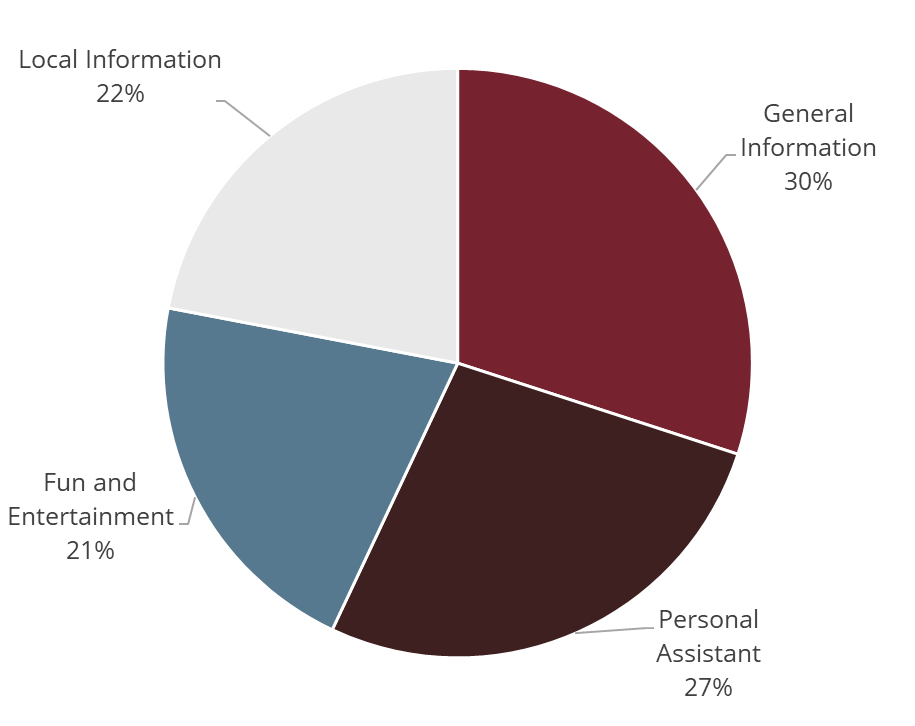Google estimates that by 2020, half of all searches will be voice-led. With only 20 percent of searches occurring by voice today, that’s a significant increase in a very short amount of time. Are you ready?
The best place to start when considering the implications of voice search on your hospital or healthcare system’s marketing strategy is to understand how it’s being used today and why. Here are a few statistics:
- 55% of teens use voice search daily (Google)
- 41% of adults use voice search daily (Google)
- 30% use voice search to obtain faster results (MindMeld)
- 24% use voice search when it’s difficult to type on a smart phone or other devices (MindMeld)
In general, the primary reason why people use voice search boils down to one common theme: convenience. And that convenience factor is underscored by the types of voice searches people are doing today. While some use voice search for entertainment, to shop, or to switch off their lights or operate in-home devices, the vast majority of voice searches are related to information retrieval . Which is not surprising given our expectation for immediate information and answers – those “micro-moments,” a term coined by Google, where we turn to our devices to know, go, do or buy.
And of these informational searches – these micro moments -, more than half involve finding something local. In fact, Bright Local reports that 58 percent of consumers have used voice search to find local information within the last year.

Source: KPCB 2016 Internet Trends, 2016
Drive Patients in Your Doors with Local Listings & Featured Snippets
Bottom-of-the-funnel searches – searches where consumers are looking to take immediate action – represent the best opportunity for hospitals and health systems to win in the voice search space today. Specifically, both local listings and featured snippets offer an opportunity to convert consumers to patients.
Since healthcare has largely caught up to other industries in understanding the value of and devising strategies and tactics around text-based search engine optimization (SEO), there’s a good chance you’ve already taken steps that positively impact voice searches without even realizing it. But that’s not to say that your current SEO and content strategy won’t need some adjusting.
So let’s take a look at each opportunity more closely:
1) Local listings
The most popular digital assistants – Amazon Alexa, Google Assistant, Microsoft Cortana, Apple Siri, and Samsung Bixby – use Google, Bing, or Yelp – or a combination of – to return local information. For example, when someone asks Google for the closest urgent cares to them, Alexa responds with information it pulls from Yelp to return “popular” results, Siri uses Google, and Microsoft relies on Bing.
So, good news! All that time and effort you’ve been spending to claim and optimize your local listings has been time well spent.
The not so good news? If you haven’t claimed your listings on any other platform than Google My Business, you likely won’t show up in voice search results for voice assistants that use Bing or Yelp – or the information returned about your organization may be incomplete or inaccurate. So you’ll want to understand what devices are being used most often in your market and devise a plan to tackle other voice search sources, such as Bing Places for Business and Yelp, as next steps.
When it comes to voice search, ensuring your organization is optimized across multiple data sources can mean the difference between business walking through your doors or your competitors’.
2) Featured snippets
The efforts you’ve put into optimizing your service line and other content for SEO can also result in opportunities to garner what’s called a Featured Snippet spot on Google.
Featured snippets are blocks of text that appear at the top of Google search results (Fig. 2).
Not only is this very valuable search real estate, but it’s also a huge asset for voice search visibility. Featured snippets are often what voice assistants read as answers to users’ questions. They can appear as text, lists, tables and video, but currently most voice answers (about 65 percent) come from text-only featured snippet results.

To snag a featured snippet spot, it’s important to understand that people search differently using their voice than when using traditional typed searches. Voice search is more conversational, using longer phrases and complete sentences. Because of this difference, it’s important to research how people talk about the questions they have, and then shift how you write your content slightly to answer those questions.
However, we DO NOT recommend you start rewriting all of your existing content! Dip your toe in the featured snippets water by conducting small experiments and see what kinds of results you get.
We DO recommend you:
- Focus primarily on opportunities around bottom-of-the-funnel searches, where you have greater potential for visibility. Competing with Mayo Clinic, WebMD, and other similar organizations with nation-wide reach and authority and who are most likely to appear for top of the funnel searches, may not be worth your time (unless you offer a very unique service). However, search is of course always changing so you’ll definitely want to stay on top of trends. What doesn’t work today may work in the future!
- Always make sure your efforts are tied to strategy; there’s nothing worse than spending time and effort to grab a featured snippet spot about bunions when your organization really wants to drive knee surgeries.
- Keep in mind that you’re more apt to snag a featured snippet spot if you already rank on the first page of search results for a particular phrase or keyword.
- Use the “People Also Ask” results in Google, which are pulled from voice searches, to help you understand what content people are searching for. Including these phrases in your content could help you show up in voice search results.
Bottom Line: The Best Approach is a Strategic One
When it comes to voice search, the best approach is a strategic one. Keep your efforts focused on your overall organization and marketing goals. Don’t try to take on too much at once – start with a focus on local listings – then experiment a bit with featured snippets and see what kind of results you get.
It’s also helpful to try out the different voice-enabled devices on the market today to get a feel for how answers are returned. Interacting with them is also a great way to remove unknowns and reduce anxiety if you’re feeling overwhelmed (plus, it’s fun and definitely entertaining). Keep tabs on what your competitors are doing in the voice search space, and read up on the latest information – including additional posts – this is a fast-moving space!
Above all, remember that voice search is just another part of your overall SEO and content strategy, not a separate initiative. That alone will help you keep voice search where it belongs – in perspective. Good luck! Let us know how it goes.
Geonetric helps health care systems and hospitals stay on top of digital trends, and we’d love to help your organization, too! For guidance on voice search or other digital marketing trends, contact us.

